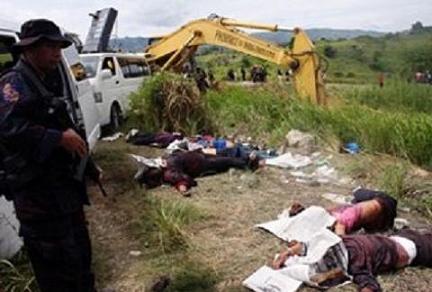by Romel Regalado Bagares
COTABATO CITY.–Peruvian forensic anthropologist Dr. Jose Pablo Baraybar didn’t like what he saw when he visited for the first time Sunday the massacre site in Barangay Salman, Ampatuan town.
“It reminded me of something—it’s just like Rwanda,” said Dr. Baraybar after spending a few hours in the area in the company of Commission on Human Rights Chair Leila M. De Lima, British forensic investigator Chris Cobb Smith and lawyers from the Center for International Law (Centerlaw).Baraybar said the “topography of the crime” in Ampatuan town is eerily similar to that he had found as a United Nations expert serving in the International Criminal Tribunal for Rwanda.
Barren hills, marked in places by an occasional clump of nipa huts, flanked a narrow dirt road that led to the scene of the carnage that claimed the lives of at least 57 people, including at least 29 journalists.
As he surveyed the area, Baraybar shook his head, remarking, “This is exactly the kind of topography that unfortunately provides an incentive for acts of impunity—its sheer remoteness keeps away public attention.”
In 1994, the genocide in Rwanda broke out and saw the systematic killing of some 800,000 Tutsis and moderate Hutus in less than 100 days by the Hutus. The East-Central African country, known as the “land of a thousand hills,” has an economy supported for the most part by subsistence agriculture.
The Peruvian expert and his British counterpart—both of whom also worked on the same cases for the International Criminal Tribunal for the former Yugoslavia—are doing a preliminary assessment of what still needs to be done at the crime scene, following the evidence-gathering already accomplished by police and National Bureau of Investigation investigators.
Baraybar heads a team of forensic investigators and lawyers deputized by the CHR to conduct an independent parallel investigation on the Ampatuan massacre. He also directed the Office on Missing Persons and Forensics of the UN Interim Administration Mission in Kosovo.
The group flew from Manila to Cotabato City and then travelled in a convoy of cars to the site. After an hour they reached the capital town of Shariff Aguak. When they passed through the palatial houses of the Ampatuans which were situated near the provincial capitol, they saw Ampatuan supporters with banners and screaming at the convoy “We love the Ampatuans!,” “Stop Blaming the Ampatuans,” among others.
From the capital town, it took them only seven minutes to reach the town of Ampatuan where the massacre happened. From the Ampatuan town center, the group reached the village of Salman in just three minutes. In the village is a detachment camp reportedly manned by paramilitary and police auxiliary militiamen when the killings happened. It was at the said detachment where the Mangundadatu convoy was stopped allegedly by policemen and militiamen on November 23, 2009.
From the detachment, the group of Dr. Baraybay turned right on a dirt road and after travelling for five kilometres through undulating hills planted to corn, banana, and papaya, they reached the site of the massacre.
There are at least three dug up holes in the site where bodies and crampled cars were uncovered. Papers, shoes, car interior parts, eyeglass case, and bullet shells are scattered around the massacre site. Despite the application of lime strewn all over the site, members of the team still smelled decaying corpse.
Baraybar and Smith declared the need to conduct further forensic examination in the area, especially considering reports that there are still unaccounted persons who may have been on the site when the Mangundadatu convoy was stopped by armed men.
When the group went back to Cotabato City, they met with two police inspectors who briefed them about how the retrieval of bodies and evidence was conducted a day after the killings happened. The police inspectors recounted the position of the corpses and the bloodied condition of the cars when they arrived in the scene of the killings.
Baraybar first came to the country to lecture in an international conference on the investigation and prosecution of extrajudicial killings, enforced disappearances and torture held in Davao last year under Centerlaw’s auspices.
(Romel Regalado Bagares is executive director of the Center for International Law, a member of the Southeast Asia Media Defense Network.)



No comments:
Post a Comment